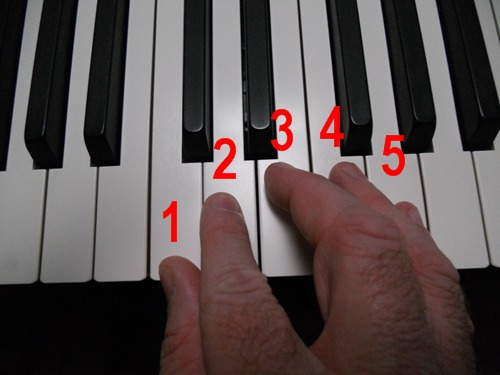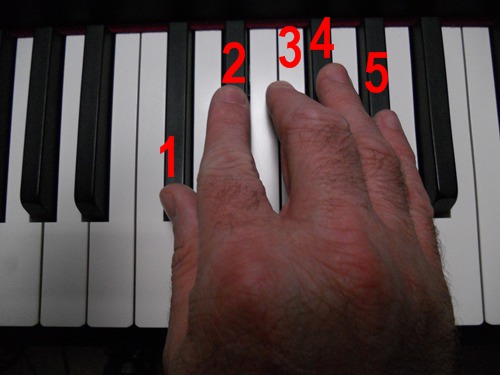Whether you realize it or not, you’ve been hearing the same chords in music over and over. This has been happening all of your life probably without you even noticing it. Today I want to focus on how to find the 3 most used chords in music in every Major key on the piano.
First, we need to define what a key of music is. It’s simply 7 different notes that you draw from to create a song or piece of music.
Key of Music = 7 Different Notes
In this case, I’m referring to a Major key of music. The Major keys are where all other keys are derived from. So for now, we’re going to be referring to those.
The key of C Major is the best staring point for learning about Major keys. This is because the key of C Major is the easiest key visualize on the piano because it happens to be all of the white keys.
 This doesn’t necessarily mean that it’s the easiest key to play in. You’ll understand that as you learn to play in other keys of music besides the key of C Major.
This doesn’t necessarily mean that it’s the easiest key to play in. You’ll understand that as you learn to play in other keys of music besides the key of C Major.
The key of C Major is a simple pattern of Whole Steps and Half Steps.
Whole step Whole step Half step Whole step Whole step Whole step
That’s what makes up these 7 different notes.
Now the really important aspect of these 7 different notes is their numbered sequence. It’s very simple. You start on the first note and count from 1 to 7. It couldn’t be any simpler. Could it?
 Now on to How to find the 3 most used chords in music in every Major key on the piano.
Now on to How to find the 3 most used chords in music in every Major key on the piano.
Let’s continue using the key of C Major as our example key.
All of these numbered tones have a corresponding chord. But for now, I want you to focus on the 1, 4 and 5 notes. It just so happens that these particular notes actually hosts the primary chords in all Major keys.
 In the key of C Major the primary chords are:
In the key of C Major the primary chords are:
 Ok, that’s simple enough. But we have 11 other Major keys of music. If you’re not familiar with all of your Major keys, how would you go about figuring out what the primary chords are for the rest of them?
Ok, that’s simple enough. But we have 11 other Major keys of music. If you’re not familiar with all of your Major keys, how would you go about figuring out what the primary chords are for the rest of them?
I’m glad you asked because I have a secret. I’m sure you won’t tell anyone so here goes. You don’t have to learn every Major key of music in order find the primary chords of all of them.
Now, I didn’t say that you don’t or shouldn’t learn all Major keys of music. I believe quite the opposite of that statement. But, there are shortcuts that you can take at the moment to help you get to where you need to go.
Let’s say at this moment that you need to find the primary chords in any given key.
You can use a strategy such as the “tetrachord plus” pattern. It’s a simple 4 note pattern plus a whole step. You can use this method to find the primary chords in any Major key. It is necessary that you know your 12 Major chords. The “techrachord plus” is going to reveal the root of each one of these primary chords. All you have to do then is build a Major chord based on each root.
The “tetrachord plus” pattern is:
Whole step Whole step Half step Whole step
For example, here’s the “tetrachord plus” pattern in the key of C Major.

The easiest way to study and learn this pattern is to find the 1 which will be the note that the key is named after. Play your thumb on that note. Then use the rest of your five fingers to play this pattern.

The note that you’ve placed your thumb on is going to the root (bottom note) of the 1 chord.
Then, the note that you’ve placed you fourth finger on is going to be the root of the 4 chord.
Then, the note that you’ve placed your fifth finger on is going to be the root of the 5 chord.
Keep in mind that this is about finding the primary chords in any Major key of music. It’s not about voicing or what finger you should use when you’re playing chords that have black keys in them. That’s really another topic for another time.
For now, just choose the key that you want by finding the root (which is the note that the key is named after) and use this pattern.
Even though you’ll find keys that share some of the same exact chords, every key of music has a unique primary chord sequence that is different from any other.
Here’s a similar key to C Major but with its own unique primary chords.

Can you find the primary chords based on the pattern alone?
If you chose G Major, C Major and D Major, you got it right.
Now let’s choose a key that’s really different from C Major.
Let’s find the primary chords of D flat Major using the “tetrachord plus” pattern.

What are the primary chords in the D flat Major example?
My first finger is on D flat so D flat is my 1 chord.
My fourth finger is on G flat so that is my 4 chord.
My fifth finger is on A flat so that is my 5 chord.
Can you see how easy it is to find the primary chords using this simple five note pattern? Here’s a fun exercise to get you up to speed on all of your primary chords in all 12 Major keys:
Sit down at your piano or keyboard. Close your eyes and reach out with one finger and find any note. Now use the “tetrachord plus” pattern that you just learned about find the primary chords of whatever key you chose.
You can do this in almost any register of the keyboard. Of course, if you move too far past the octave below middle C, your chords will sound pretty muddy so I’d stay above that register.
You can also use your left hand if you would like, but I’d use my right hand to start with. Now you know how to find the 3 most used chords in music in every Major key on the piano.
Here’s a very visual instructional guide that you can download for free. It expands on the content in this article and well help you to understand music in a visual and fun way. You can download it here just by subscribing to the free Color Notes Ezine.
Find out more about Color Score! The easiest way to learn to play the piano like a professional.
Until next time, Go Play!
Greg Lee
Latest posts by Greg Lee (see all)
- What is a minor/Major 7 Chord? - October 26, 2023
- 7 Chord Substitutions that Professionals Use - October 19, 2023
- 5 Simple Chord Tricks to Sound Amazing - October 5, 2023





